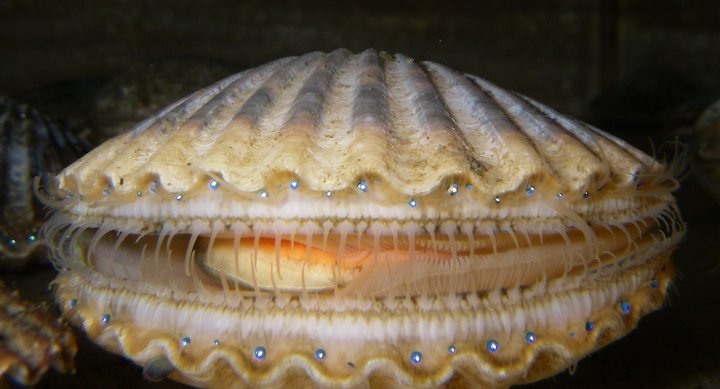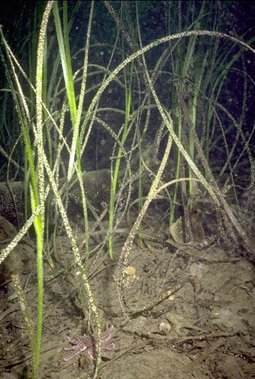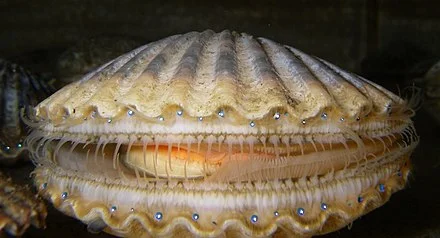
Todd McLeish: Seeking strategies for sustaining bay scallops
Bay scallop staring at you with its blue eyes
From ecoRI News (ecori.org)
In the Great Salt Pond on Block Island, native bay scallops are thriving like nowhere else in Rhode Island. Scientists from The Nature Conservancy survey the 673-acre tidal harbor every autumn and have recorded hundreds of scallops each year, despite as many as 50 recreational shellfishermen harvesting scallops from the pond each November and December.
The same cannot be said of the rest of the Ocean State’s waters, however, where bay scallops are few and far between.
On Block Island, Diandra Verbeyst leads a three-person team of Nature Conservancy scuba divers and snorkelers who monitor 12 sites around the Great Salt Pond. They have counted an average of 225 scallops annually since 2016, up from just 44 observed by previous observers in 2007, the first year of monitoring.
“There are slight rises and falls from year to year, but the population is pretty stable,” Verbeyst said. “Based on the 12 sites we monitor, the population is indicating that there is spawning happening each year, and there is recruitment to the population.”
In addition to scallop data, Verbeyst and her team also collect information on water quality and other environmental conditions during their surveys.
“The scallops are an indication that the ecosystem is healthy and doing well, and for me, that’s fascinating in itself,” she said. “No matter where you are in the pond, there’s a good chance you’ll see a scallop.”
Bay scallops are bivalve mollusks with 30-40 bright blue eyes that live in shallow bays and estuaries up and down the East Coast, preferring habitats where eelgrass is abundant. They are short-lived animals — most don’t live more than two years — and are significantly smaller than sea scallops, which are found farther offshore and are harvested by the millions by New Bedford-based fishermen.
Chris Littlefield, a Nature Conservancy coastal projects director and former part-time shellfisherman on Block Island, recalled collecting scallops as a child in the Great Salt Pond 50 years ago, and he has been gathering them in small numbers for his family’s consumption ever since. He said the scallop population received a boost in 2010, when immature scallops grown at the Milford {Conn.} Laboratory of the National Oceanic and Atmospheric Administration were dispersed into the pond in a project funded by the Natural Resources Conservation Service.
“That project broke through some kind of threshold,” Littlefield said. “Scallops weren’t as abundant before that, and they used to be confined to certain key locations and that was it. But now they’re more abundant and more people are finding them and harvesting them.”
Unlike Nantucket, Martha’s Vineyard and a few locations on Cape Cod and Long Island, where regular seeding of immature bay scallops has resulted in thriving commercial fisheries, Rhode Island has a tiny commercial fishery for bay scallops — fewer than three fishermen participate — and the fishery is not sustainable.
Anna Gerber-Williams, principal marine biologist for the Rhode Island Department of Environmental Management’s Division of Marine Fisheries, just completed the first year of a three-year effort to assess the state’s bay scallop population. She is focused primarily on the salt ponds in South County, especially Point Judith Pond and Ninigret Pond, which historically had healthy bay scallop populations.
“We manage and regulate the bay scallop harvest, but besides Block Island, we haven’t had an actual assessment of what the population looks like in Rhode Island,” Gerber-Williams said. “We know it’s pretty low, and we know the actual commercial harvest numbers are very low. But we don’t have anything to base our management on. The hope is that this project can turn into more long-term monitoring, similar to what’s done on Block Island, and maybe lead to restoration efforts.”
Based on her first year of surveys, Gerber-Williams said there are self-sustaining populations of bay scallops in Point Judith Pond, and their abundance can fluctuate significantly from year to year.
“Scallops are very habitat-dependent,” she said. “The habitat in the salt ponds is very patchy, and those patches are very small.”
Unlike clams, which bury themselves in the sand, bay scallops sit on the seafloor and can swim around by rapidly opening and closing their shell, making them difficult to track and count. Gerber-Williams said they are threatened by several varieties of crabs, which can easily crush the scallops’ shells with their claws.
“Part of the scallop’s strategy is to hide from the crabs in the eelgrass,” she said. “When they’re younger, they attach themselves to eelgrass blades to keep themselves above the bottom and out of reach of predators.”
Dan Torre at Aquidneck Island Oyster Co. experimented this year with growing bay scallops in cages in the Sakonnet River off Portsmouth. He bought scallop seed from area hatcheries last July, and they are approaching marketable size now. He has contracted with one local restaurant to buy his experimental crop, with hopes of scaling up the operation next year.
“I believe there’s a market, but it’s a niche market,” he said. “Normally with sea scallops, you sell just the shelled adductor muscle, but with bay scallops you sell the whole animal. The shelf life isn’t the longest, but it seems like there are a bunch of restaurants that are eager to try them.”
In an effort to figure out how best to restore wild bay scallop populations in the region, the Rhode Island Commercial Fisheries Research Foundation is collaborating with The Nature Conservancy to synthesize what is known about the history of the bay scallop population and fishery in Point Judith Pond.
According to Dave Bethoney, the foundation’s executive director, it will be combined with information about scallop fisheries in Massachusetts and Long Island, N.Y., as a first step to developing a restoration plan.
“How to make them sustainable is the real puzzle,” Bethoney said. “Even successful efforts on Long Island are based on a seeding plan — getting scallops every year from aquaculture facilities to replenish them. They have successful populations, but they’re not self-sustaining. I don’t know how we change that.”
Gerber-Williams agreed.
“In my opinion, the way to boost populations here and keep them at a level that’s sustainable for a good fishery in Rhode Island, we would have to have a seeding program similar to what they have in Long Island and Martha’s Vineyard,” she said. “Every year they put out thousands of baby bay scallops. They seed their salt ponds every single year to keep a decent fishery going.
“So the next step for us would be to do that kind of seeding program in Rhode Island. We’re in the process of creating a restoration plan for various species of shellfish in Rhode Island, and my hope is that bay scallops are a part of that.”
Hopefully the current researchers go back to the North Cape shellfish injury restoration project, which included release of bay scallop seed into the South County salt ponds, to learn about what worked or did not work for the multi-year that wrapped up by 2010. The reports are available and some of us who worked on the project are available to discuss challenges and successes.
Todd McLeish is an ecoRI News contributor.
Eelgrass is prime habitat for bay scallops.
Environmental factors in decline of shellfish along East Coast
Bay scallop.
Via ecoRI News (ecori.og)
Researchers studying the sharp decline between 1980 and 2010 in documented landings of the four most commercially important bivalve mollusks — eastern oysters, northern quahogs, soft-shell clams and northern bay scallops — have identified the causes.
Warming ocean temperatures associated with a positive shift in the North Atlantic Oscillation (NAO), which led to habitat degradation including increased predation, are the key reasons for the decline of these four species in estuaries and bays from Maine to North Carolina, according to the National Oceanic and Atmospheric Administration (NOAA).
The NAO is an irregular fluctuation of atmospheric pressure over the North Atlantic Ocean that impacts both weather and climate, especially in the winter and early spring in eastern North America and Europe. Shifts in the NAO affect the timing of species’ reproduction and growth, the availability of phytoplankton for food, and predator-prey relationships, all of which contribute to species abundance. The findings appear in Marine Fisheries Review.
“In the past, declines in bivalve mollusks have often been attributed to overfishing,” said Clyde Mackenzie, a shellfish researcher at NOAA Fisheries’ James J. Howard Marine Sciences Laboratory, in Sandy Hook, N.J., and lead author of the study. “We tried to understand the true causes of the decline, and after a lot of research and interviews with shellfishermen, shellfish constables, and others, we suggest that habitat degradation from a variety of environmental factors, not overfishing, is the primary reason.”
Mackenzie and co-author Mitchell Tarnowski, a shellfish biologist with the Maryland Department of Natural Resources, provide details on the declines of these four species. They also note the related decline by an average of 89 percent in the numbers of shellfishermen who harvested the mollusks. The landings declines between 1980 and 2010 are in contrast to much higher and consistent shellfish landings between 1950 and 1980.
Exceptions to these declines have been a sharp increase in the landings of northern quahogs in Connecticut and American lobsters in Maine. Landings of American lobsters from southern Massachusetts to New Jersey, however, have fallen sharply as water temperatures in those areas have risen.
“A major change to the bivalve habitats occurred when the North Atlantic Oscillation index switched from negative during about 1950 to 1980, when winter temperatures were relatively cool, to positive, resulting in warmer winter temperatures from about 1982 until about 2003,” Mackenzie said. “We suggest that this climate shift affected the bivalves and their associated biota enough to cause the declines.”
This graph shows the rise and fall of soft-shell clam landings from 1950 to 2005. (Clyde Mackenzie)
Research from extensive habitat studies in Narragansett Bay and in the Netherlands, where environments including salinities are very similar to the northeastern United States, show that body weights of the bivalves, their nutrition, timing of spawning, and mortalities from predation were sufficient to force the decline. Other factors likely impacting the decline were poor water quality, loss of eelgrass in some locations for larvae to attach to and grow, and not enough food available for adult shellfish and their larvae.
“In the Northeast U.S., annual recruitments of juvenile bivalves can vary by two or three orders of magnitude,” said Mackenzie, who has been studying bay scallop beds on Martha’s Vineyard with local shellfish constables and fishermen monthly during warm seasons for several years.
In late spring to early summer of this year, a cool spell combined with extremely cloudy weather may have interrupted scallop spawning, leading to what looks like poor recruitment this year. Last year, Nantucket and Martha’s Vineyard had very good harvests due to large recruitments in 2016.
“The rates of survival and growth to eventual market size for shellfish vary as much as the weather and climate,” Mackenzie said.
Weak consumer demand for shellfish, particularly oysters, in the 1980s and early 1990s has shifted to fairly strong demand as strict guidelines were put in place by the Interstate Shellfish Sanitation Conference in the late 1990s regarding safe shellfish handling, processing, and testing for bacteria and other pathogens.
Enforcement by state health officials has been strict. The development of oyster aquaculture and increased marketing of branded oysters in raw bars and restaurants has led to an increase in oyster consumption in recent years.
Since the late 2000s, the NAO index has generally been fairly neutral, neither very positive nor negative. As a consequence, landings of all four shellfish species have been increasing in some locations. Poor weather for bay scallop recruitment in both 2017 and 2018, however, will likely mean a downturn in landings during the next two seasons.
Oil-spill settlement helps fund shellfish-restoration projects around Buzzards Bay
By ecoRI News staff
BOURNE, Mass. — Buzzards Bay recreational fishermen may soon have access to improved scallop, oyster and quahog populations in town waters for recreational harvests, thanks to settlement funding being used by the Massachusetts Division of Marine Fisheries and The Nature Conservancy to restore natural resources injured by a 2003 oil spill near the bay’s entrance.
In April 2003, the Bouchard Transportation Co. Barge #120 spilled about 98,000 gallons of fuel oil into Buzzards Bay. The oil spread along more than 90 miles of shoreline and affected wildlife, shellfish beds, recreational activities and habitat. Eight years later, natural resource agencies secured a $6 million settlement to restore wildlife, shoreline and aquatic resources and lost recreational uses.
With the settlement money, the Buzzards Bay/Bouchard B-120 Trustee Council — the U.S. Fish & Wildlife Service, National Oceanic and Atmospheric Administration (NOAA), and state agencies from Massachusetts and Rhode Island — has funded 26 projects. Nature Conservancy bay scallop and oyster restoration projects and Massachusetts Division of Marine Fisheries quahog and oyster restoration work are among the recently funded projects. These restoration efforts are targeting recreational shellfisheries within the impacted Buzzards Bay communities.
“Recreational shellfisheries were tragically affected by the Bouchard spill, with some municipal harvesting areas closed for six months or longer during the peak harvest season due to the oiling,” said John Bullard, regional administrator for NOAA Fisheries Greater Atlantic Region.
The two settlement-funded conservancy shellfish projects are underway. In early June, the conservancy, in collaboration with Bourne municipal shellfish officials, deployed 7,500 caged adult bay scallops in town waters. The goal is to create a spawner sanctuary as an effective way of restoring sustainable bay scallop populations and supporting seasonal recreational shellfishing.
“Bay scallops are a historically and culturally significant species,” said Steve Kirk, the conservancy’s Massachusetts coastal restoration ecologist. “While populations have always fluctuated, we want to bring them back by creating spawner areas to ultimately boost the wild population.”
In collaboration with the town of Fairhaven, the conservancy is using additional settlement money to restore a one-acre oyster bed in Nasketucket Bay.
The Buzzards Bay Coalition is supporting the scallop and oyster restoration work by securing project volunteers and hosting outdoor educational opportunities focused on this shellfish restoration work.
Also funded by the settlement are projects led by the Massachusetts Division of Marine Fisheries, including multiyear hard clam (quahog) relay and oyster restoration projects. This work involves moving adult quahog stock from an area closed to shellfishing in the Taunton River to designated transplant sites in the waters of Bourne, Dartmouth, Gosnold, Marion, Mattapoisett, New Bedford, Wareham and Westport.
Upwellers for nursery grow-out will be installed and juvenile quahogs will be outplanted in Dartmouth, Wareham and Fairhaven. Outplanting of single field-plant-sized oysters will also take place in Bourne, Marion and Wareham.
The goals of the Division of Marine Fisheries-led projects are to increase overall municipal quahog populations and enhance recreational shellfisheries.
“Boosting the local quahog stocks for local recreational fishermen will be a tangible benefit to those impacted by the spill,” said Division of Marine Fisheries director David Pierce. “Once the transplanted clams are certified clean and held for at least one spawning season after a minimum of six months from relocation, fishermen will have access to this crop. We hope there will be increased quahog reproduction from these transplants, resulting in increased and sustainable harvests from their progeny in the future.''



